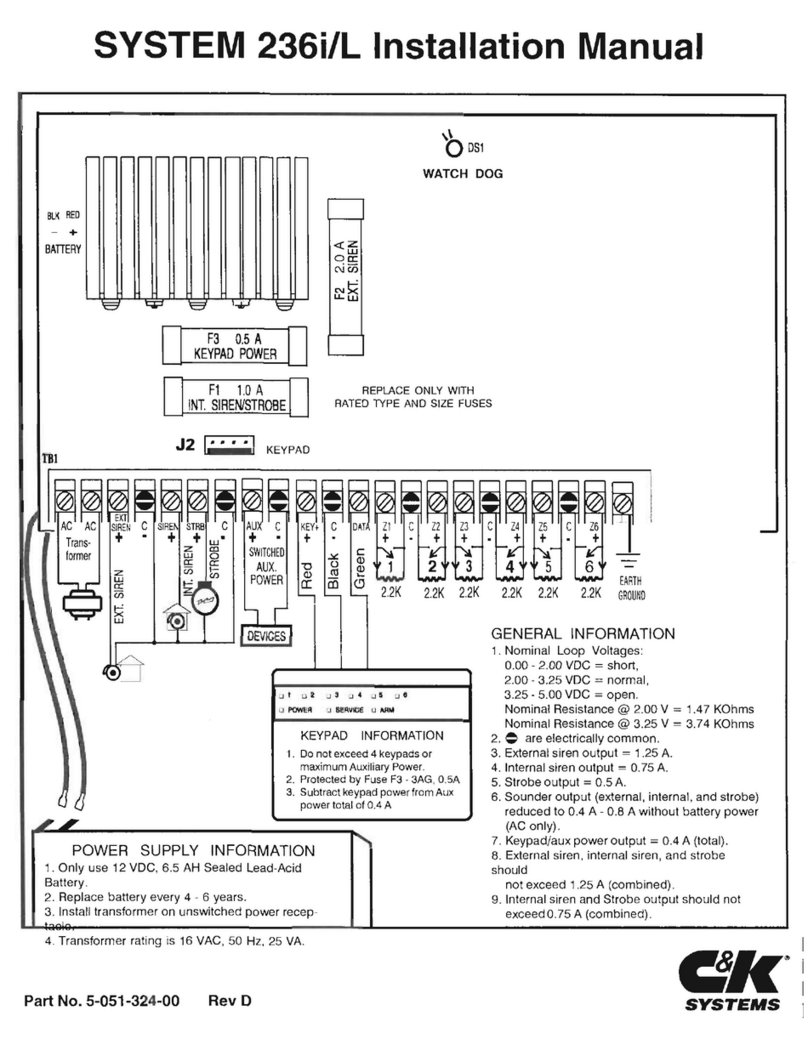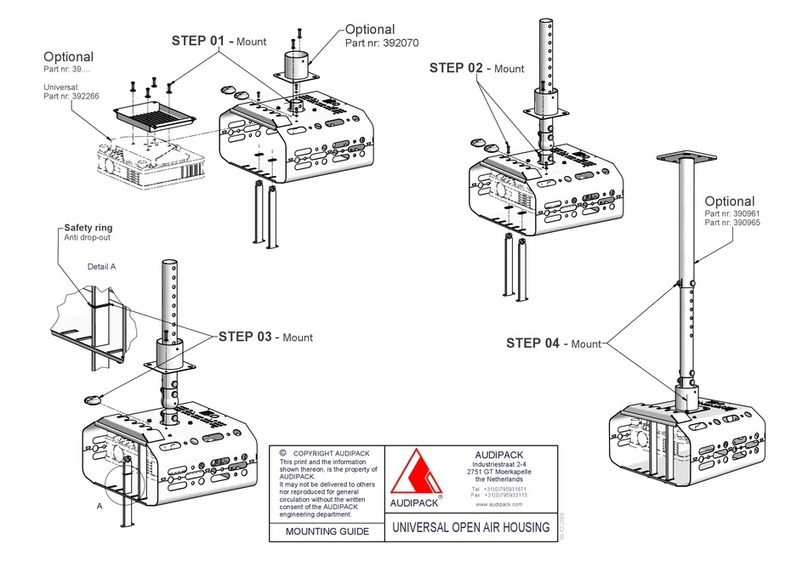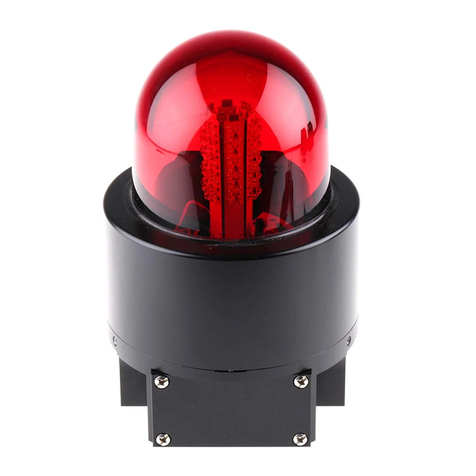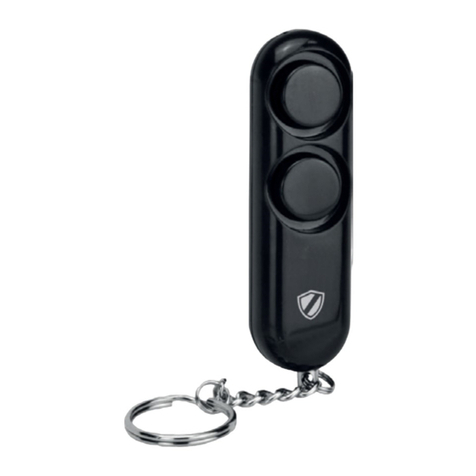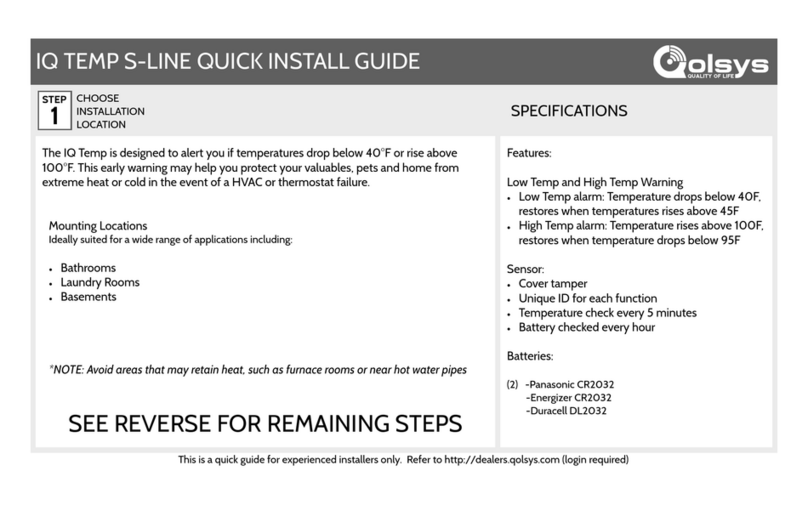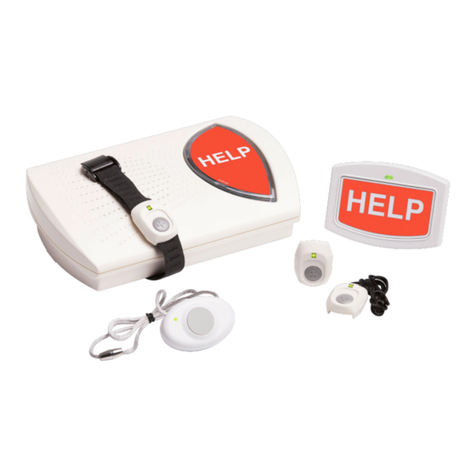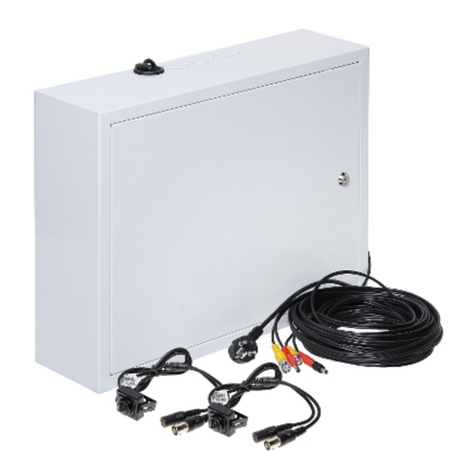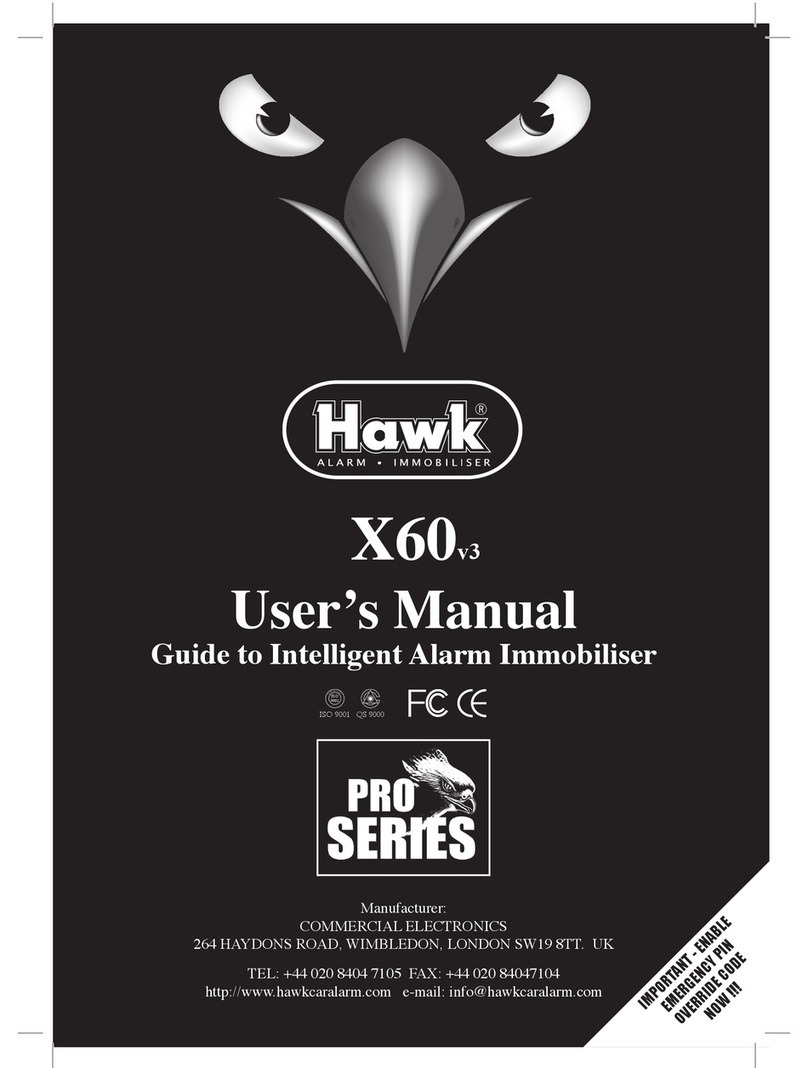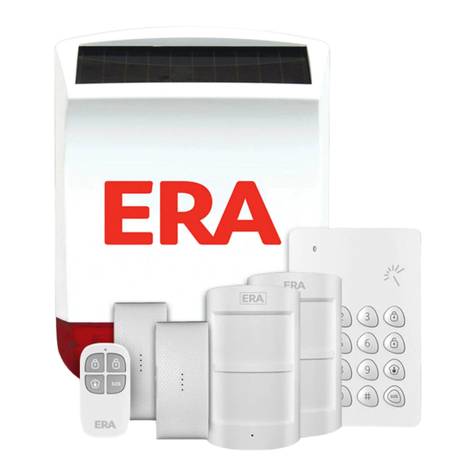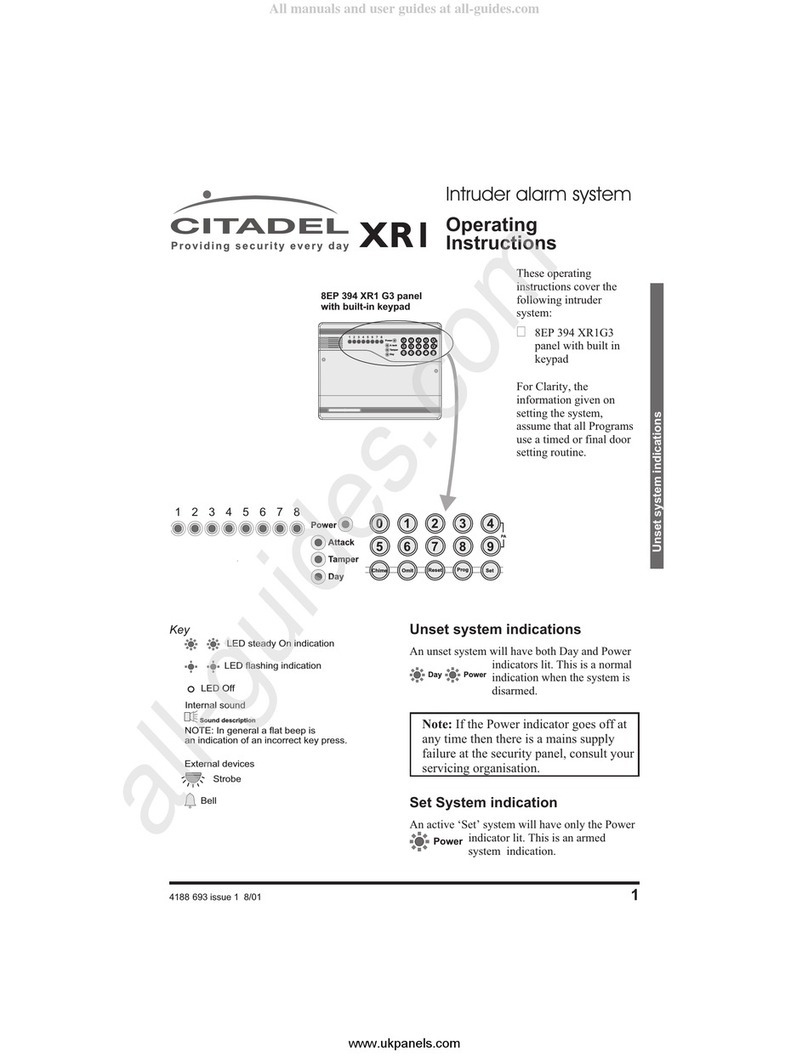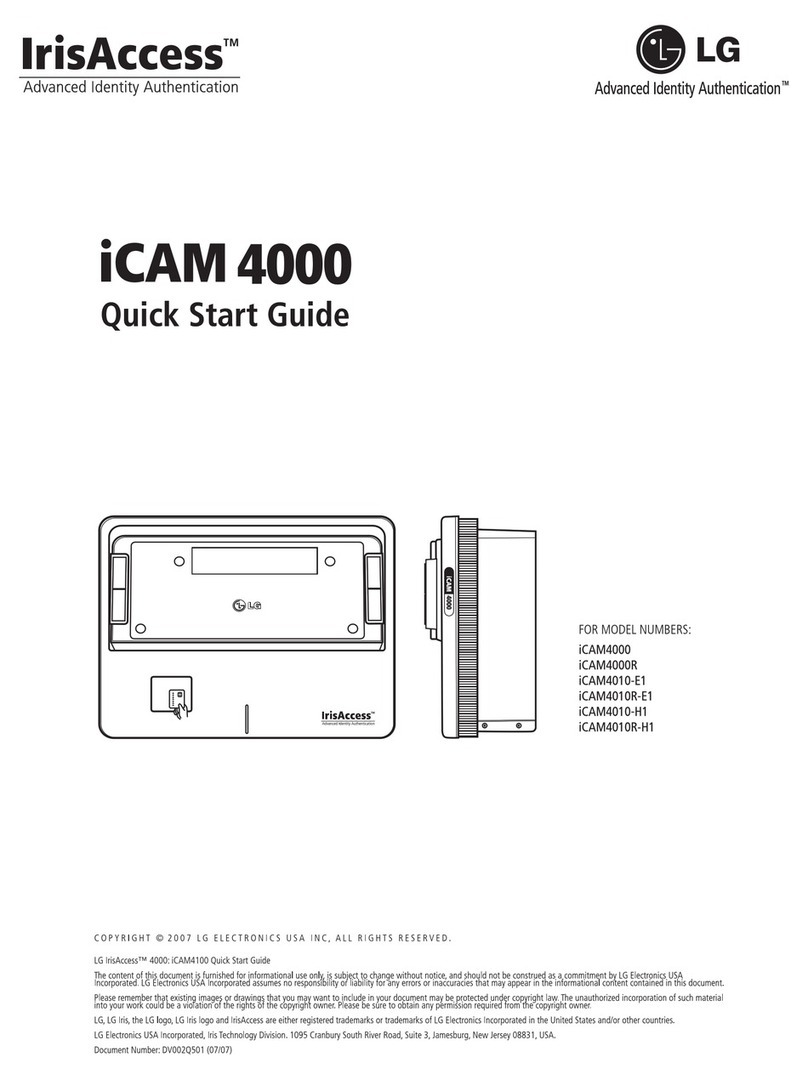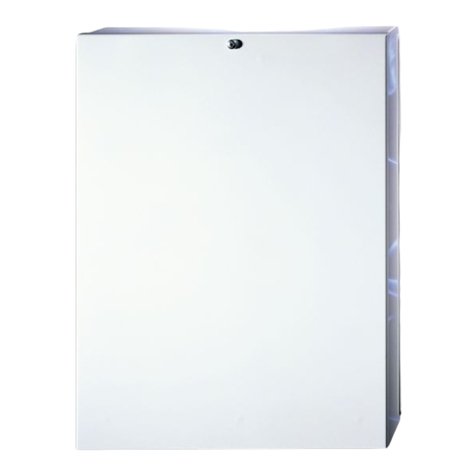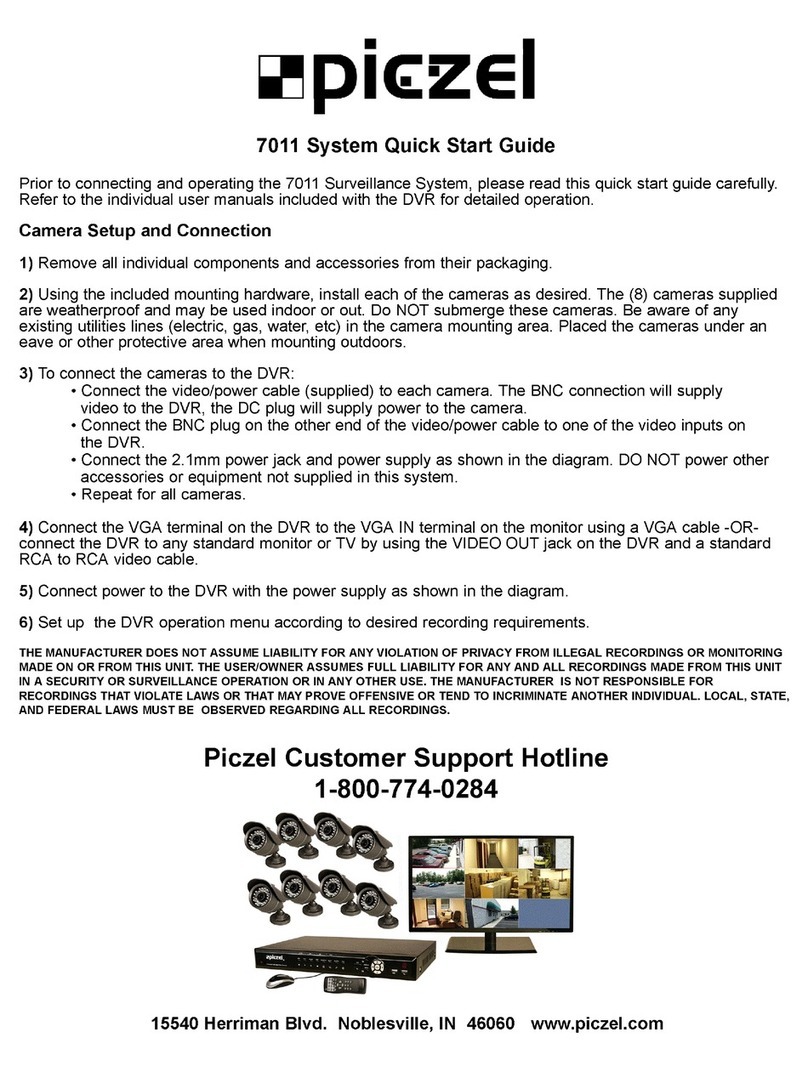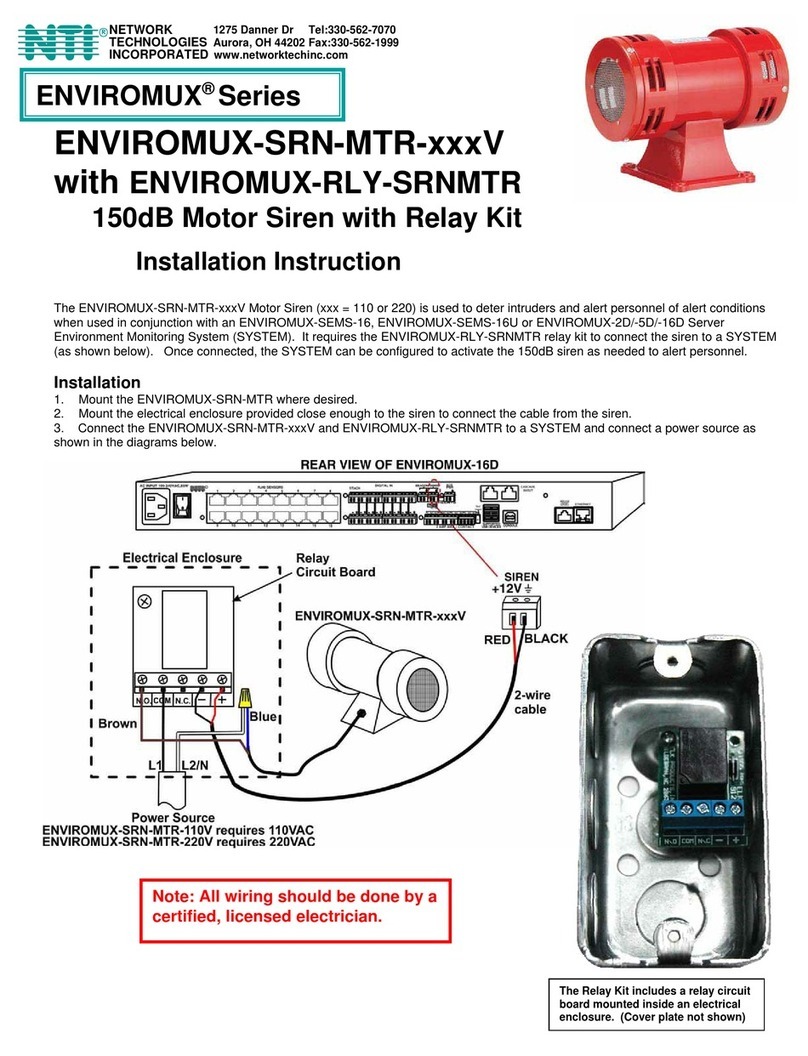C & K Systems System 238 User manual

SYSTEM 238 Installation Manual
BLK
RED
BATTERY
DIRECT
CONNECT
U1
J2
DS1
WATCH
DOG T1
TB1
DEVICES
UNSWITCHED
AUX
POWER
- Protected by
Fuse F2:
3 AG, 0.75 A
- Shared with
keypads and
AUX POWER
KEYPAD
INFORMATION
- Do not exceed
4 keypads or
max AUX POWER
- Protected by Fuse
F3: 3 AG, 0.75 A
WARNINGS:
- For continued protection
against risk of fire, replaces
fuses only with fuses of same
type and rating
- Disconnect AC, battery, and
phone cord BEFORE servicing
2.2K
EOL 2.2K
EOL
2.2K
EOL
2.2K
EOL
2.2K
EOL
2.2K
EOL
2.2K
EOL 2.2K
EOL
Capacity for
emergency standby
at least 4 hours
- Connect ground wire from door hinge to earth ground using
16 AWG, green jacketed, solid-conductor wire
GENERAL INFORMATION
- All outputs are power limited
- If programmed for EOL or Supervised loop, the 2.2K ohm EOL
resistor (Model 9.X, 2.2K) must be at end of circuit
- Loop 8 can be used as standard loop or used for switched 10-
12.5 VDC at 50 mA for 2-wire powered devices. Loop 8 can
support up to 10 BRK Model 2400 2-wire smoke detectors.
- Loop voltages:
Loops 1 - 8
0 - 2.5 VDC = short
2.5 - 8.5 VDC = normal
8.6 - 15 VDC = open
- Install transformer on unswitched power receptacle
- Only use 12 VDC, 6.5 AH sealed lead-acid battery
POWER SUPPLY INFORMATION
- Replace battery every 3 - 5 years with C&K Model 1265
- Standby time with 1 keypad is 16 hours at 250 mA
- Power demand for AUX POWER, keypads, and sounders
not to exceed maximum ratings
Fuse F4
3 AG, 3 A
battery
protection
- are electrically common
AUDIBLE
10.5-13.5 VDC
Protected by
Fuse F1: 3AG,
2.5 A
16.5 VAC
25 - 40 VA
50 / 60 Hz
SWITCHED
AUX
POWER
P/N 5-051-162-00 Rev J
All ratings listed on this page are in compliance
with UL 985, UL 1023, and UL 1635.
NOTE:
To be in compliance with UL 365 and UL 609,
total power from Sw/Aux, Aux, and Key+
Terminals not to exceed 150 mA combined.
AUXCCACAC +-+-+ +-++- ++- -++
BELL SW/AUX KEY+ DATA CLK C
Z1 Z2 Z3 C Z4 Z5 C Z6 Z7
++C Z8 Tip Ring T1 R1
PHONE
CORD
- 9.X PCF Red = incoming ring
Green = incoming tip
Gray = seized ring
Brown = seized tip
Blue = tamper
Orange = tamper
WARNING: Circuit Damage May Result
From Incorrect Wiring Connections.
- Remove AC and battery power before replacing fuses
- Maximum battery charge current = 350 mA
CAUTION:
Total power from Bell, Sw/Aux, Aux and
Key+ Terminals NOT to exceed 1.3 A,
combined (also seeNOTE: below)
12 VDC
6.5 AH
sealed lead-acid

SYSTEM 238 Installation Manual
2
Subject Page No.
System 238 Terminal Label Front Cover
UL Compliance 2
Installation 2 - 3
Wiring the Panel 3 - 4
System Start-Up 4
Keypad Setup 4 - 5
Addressing Keypads 5
Factory Default Settings 5
Programming Options (Alphabetical List) 5 - 6
Programming the Panel 6
Programming with the LED Keypad 6
Programming with the Alpha Keypad 6
Entering Hexadecimal Numbers 6
Programming the Alpha Keypad 6 - 7
Programming Letters & Numbers 7
Special Function Keys 7
Programming Options (Numerical Order) 8-18
Keypad Label Drawer 19
Telephone Line Problems 19
Watchdog Indicator 19
Keypad Operation Command Summary 20
Help with Common Problems (Troubleshooting) 21 - 22
Reducing False Alarms 23 - 24
Warranty Information 25
Programming Worksheets 26 - 27
Table of Contents
Scope of This Manual
This manual contains basic installation and programming information
for the SYSTEM 238. For additional information about using or
programming the system, please refer to the SYSTEM 238 Keypad
Manual, Alpha Keypad Manual, or Commander II/Monitor II Operating
Manual.
BEFORE YOU START
12. The unit must not be programmed to dial a police station.
13. Use screws (supplied) to secure cover or a lock must be
installed on the cabinet.
14. All devices must be UL listed.
Accuracy
This manual has been carefully checked for accuracy. However, C&K
SYSTEMS assumes no liability for inaccuracies or actions resulting
from the use of this manual. In addition, C&K reserves the right to
modify the SYSTEM 238 hardware, software, and manuals without
prior notice.
The SYSTEM 238 is in compliance with Underwriters Laboratories,
Inc. Standards UL 985, Household Warning System Units; UL 1023,
Household Burglar Alarm System Units; and UL 1635, Digital Burglar
Alarm Communicator System Units. The following programming
restrictions must be observed to meet UL standards.
UL COMPLIANCE
1. The audible must be programmed to sound at least four
minutes before silencing.
2. No zone may be programmed for silent alarm.
3. Fire zones must be programmed for pulsing audible alarm.
4. Burglar zones must be programmed for a steady audible.
5. Burglar loops (non-24-hour loops) must be programmed
for NO/NC with EOL.
6. No Entry Delay may be greater than 45 seconds.
7. No Exit Delay may be greater than 60 seconds.
8. The Dynamic Battery Test must be enabled.
9. The Unit Status Report must be enabled.
10. The 24-hour Check-in must be enabled.
11. No Delay Before Dial may be programmed for the
communicator.
The following additional restrictions must be observed to meet
Grades A and B Mercantile Premises Alarm Systems/Safe and
Vault Alarms Systems under UL 365, Police Station Connected
Burglar Alarm Units and Systems and UL 609, Local Burglar Alarm
Units and Systems.
Mounting
The SYSTEM 238 should be mounted in a location which allows
convenient access to AC power, telephone connections, and earth
ground.
• Remove the circuit board from the cabinet. This will prevent
possible damage to the circuit board when removing the knock-
outs.
• Remove the knock-outs.
• Mark the screw mounting holes on the wall.
• Mount the cabinet at the desired height and pass the cables
through the knock-outs.
• Replace the circuit board, remembering to connect the ground lug
to the lower left corner of the circuit board.
• Reconnect thespadelugtothelowerdoorhinge.This providesthe
earth ground connection for the door.
INSTALLATION
Keypad Requirements
The keypad may not have the EMERGENCY symbol ( ) on it. If your
keypad has this symbol, remove the key and replace it with one of the
blank keys provided.
Not shuntable
.
Supervised
- latching for heat
- resetting for smoke
.NO/NC with EOL
.
Pulsing audible
.Steady Audible
.
24-hour arming
.No Delay Before Dial
.
No Delay Before Dial
.BURGLAR LOOP
FIRE LOOP
Zone Programming
1. The audible must be programmed to sound at least 15 minutes
before silencing.
2. The ring-back function must be activated.
3. The control panel must be mounted in an enclosure that is:
(a) Attack-resistant (C&K Model # 2330-UAC)
(b) Secured with a key-lock and six (6) #6 X 1¼" sheet metal
screws.
(c) Tamper protected against cabinet door opening and
removal from mounting surface.
(d) For safe and vault applications the control panel must be
monitored by a UL Listed shock sensor suitable for the
protection of sheet metal enclosures.
4. The Ademco Model AD10-12 bell with Model AB bell housing
must be used.
5. The power and tamper wiring between the bell and the control
panel must be completely enclosed in rigid conduit or electric
metallic tubing for a Grade A system or flexible conduit for a
Grade B system.
6. Zone(s) monitoring tamper circuitry must be 24 hour and non-
shuntable.

SYSTEM 238 Installation Manual
3
Earth Ground
To ensure the effectiveness of the lightning and transient protection
circuits, the control panel must be connected to "Earth Ground".
Ideally, this should be a common ground to the power lines, telephone
system, and security system. This type of ground, called a "Unified
Earth Ground", provides the best protection. The ground connection,
from a grounding rod, cold water pipe or other established ground
point, is made to the green jacketed wire providing a ground to the
panel housing. WIRING THE PANEL
Standby Battery
The SYSTEM 238 is designed to operate with a 12 volt, 6.5 Ah, sealed
lead-acid battery (C&K Model 1265). Do not use non-rechargeable
batteries or batteries other than sealed lead-acid.It is recommended
that you replace the standby battery every three to five years.
Connectthe redleadtothe batterypositiveterminal and theblacklead
to the battery negative. The battery is reverse-polarity protected by a
3 AG, 3 amp, fast-blow fuse (F4).
NOTE: If any fuse opens, remove AC and DC power, remove
the short oroverloadcondition, then replacethefuse
before restoring power. Do not substitute a higher
rated fuse.
Electromagnetic Interference
Vibratinghornscanproduceelectromagneticinterference(EMI).While
EMI will not damage the SYSTEM 238, it can cause transmission
errors and mis-dialing. To minimize EMI, install a 0.01 mfd, 100 volt
capacitor across the terminals of the horn. The capacitor must be
located in the horn.
AUXILIARYPOWER
The SW/AUX terminal provides positive 10 - 12.5 VDC
power for devices that require switched power for reset-
ting. Typical devices are glass-break and smoke detec-
tors.
The C terminal provides power common.
The AUXterminal supplies uninterrupted positive power.
Fuse F2
The SW/AUX and AUX terminals are protected by a 0.75 amp, 3 AG,
fast-blow fuse (F2).
The KEY+ terminal (red) provides 11 - 14 VDC keypad power.
The DATA terminal (green) is data from the keypad to the panel.
The C terminal (black) is common.
ARMING STATIONS
The CLK terminal (white) is the clock line.
Maximum wire length for connecting any keypad is 500' (152 m) of 22
AWG (0.643 mm) copper wire.
The SYSTEM 238 is capable of addressing up to 8 Alpha keypads.
LEDkeypadsdonotrequireaddressing.EachLEDkeypaduses35mA
of current. Each LCD keypad uses 64 mA of current. See Available
Power for current limitations. See page 4 for additional information on
keypad setup.
Terminal Labels:
SW/AUX, C & AUX
Terminal Labels:
C, KEY+, DATA, & CLK
LOOP INPUTS
Eachloopisindependently
configured through pro-
gramming. Loops can be
wired with an open circuit
switch, or closed circuit
switch,orwith a2.2Kohm
end-of-line(EOL)resistor.
When programmed as
EOL, either an open or a
short will be reported as
analarmifthesystemisin
an armed state.
-
+
N.O.
Alarm
N.C.
Alarm
EOL Loop
Terminal Labels: Z 1 - Z 8 & C
Fuse F3
TheKEY+terminalisprotectedbya0.75amp,3AG,fast-blowfuse(F3).
Terminal Label:
AC
AC power is supplied by a 16.5 VAC, 25 - 40
VA transformer at 50 or 60 Hz. The transformer
mustbeaULlistedClass2transformer.Connect
the secondary of the transformer to the terminals labelled AC. Use
at least 18 AWG (1.02 mm) wire to reduce voltage drops. The
primary side of the transformer must be connected to an
unswitched receptacle. Do not connect primary to Ground-
Fault-Interrupt (GFI) circuits. Secure the transformer to the wall.
AC POWER
AC Power Failure
If an AC power failure lasts more than 15 minutes, the keypads will
display a system trouble. An AC failure report will be sent, if pro-
grammed. When AC is restored for five minutes, a restoral report will
be sent.
Precautions
Do not share the secondary of the transformer with other
devices. A foreign ground can damage the power supply,
voiding the warranty.
Do not use any transformer other than that specified in
the AC POWER section above.
Available Power
ThemaximumtotalpoweravailablefromtheAudible,AUX(Switched
and Unswitched), and Keypad is 800 mA. The switched auxiliary,
unswitched auxiliary, and keypads share the same power bus.
Combined power for these outputs should not exceed 500 mA**.
NOTE: The 50 mA switched power available on Loop 8 is
part of the total 500 mA AUX power.
** To comply with UL 365 and UL 609, this value must
be reduced to 150 mA.
Terminal Label:
BELL & C
AUDIBLE OUTPUT
The BELL terminal provides up to 1.3 amps at
10.5 - 13.5 VDC . The type of voltage (steady,
pulsed, chirp) and the time is programmable.
Fuse F1
TheBELL terminal isprotectedby a 2.5amps,3 AG fast-blowfuse(F1).

SYSTEM 238 Installation Manual
4
ALPHA KEYPAD INFORMATION
The Alpha keypad uses a top viewing display. This means the display
reads most clearly when viewed from a top angle rather than straight
on or from below. Mounting the keypad at the light switch level and
adjusting the viewing angle gives the best viewing results.
+When operated as a Super-
vised Loop, an open will be
reported as a Trouble.
Whetherthe systemisarmed
or disarmed. A short on a
Supervised Loop will be re-
ported as an alarm if the sys-
temisarmed,butwillhaveno
effect if the system is dis-
armed.
-
SupervisedLoop
N.C.
Trouble
N.O.
Alarm
Loop 8
Terminals C and Z8 are a standard loop that can also power 2-wire
devices. It supplies 10 - 12.5 VDC at 50 mA. Use Loop 8 to power 2-
wire glass-breaks and smoke detectors.
1. Position the tamper switch inside the cabinet at the lower right
corner of the cabinet. For the wall tamper, the plunger should go
through the small hole in the back of the cabinet. For the door
tamper,theplungershouldfaceoutfromthecabinet.Referto the
drawing below.
2. Connect the tamper switches in series and wire the tamper
terminals to a dedicated zone of the control panel.
3. Program the dedicated zone as desired: NC, EOL, 24-hour, etc.
Once the tamper switches are installed, opening the cabinet door or
removing the cabinet from the wall will result in a tamper signal at the
panel.
TAMPER SWITCH INSTALLATION
C&K has designed the SYSTEM 238 cabinet to use the Ademco
Model 19 tamper switch. The cabinet is constructed in order to
accommodate two switches. One tamper for the cover and a second
switch for a wall tamper. To install the tamper switches:
Tamper Switches installed in the SYSTEM 238 cabinet
LEAD-ACID
BATTERY
PRINTED CIRCUIT
BOARD
WALL
TAMPER SWITCH
DOOR
TAMPER SWITCH
TELEPHONE INTERFACE
ConnecttheSYSTEM238tothephonelineusing
the 9.X PCF cord (not included). The cord has an
8-pin telco plug on one end. Plug the telco end
directlyintothephonecompaniesRJ31orRJ38X
jack.ConnecttheflyingleadstotheSYSTEM238
PCB as outlined in the next column:
KEYPAD SETUP
Voltage Variations
Output voltages at terminals 5, 7, and 8 may vary between 9.0 and
14.4 VDC (worst case), depending on the load, battery condition, and
AC line voltage.
SYSTEM START-UP
Five minutes after the panel is powered up, it will dynamically test the
standby battery by interrupting AC power for two minutes and monitor-
ing the battery under load.
Standby Battery Time with One LED Keypad
AUX POWER DRAIN*
50 mA 32 hours
STANDBY TIME
* Total power for all keypads, auxiliary, and Loop 8
150 mA
250 mA
500 mA
24 hours
16 hours
10 hours
TB1
IfyoureplacethebatteryafteraSYSTEMTROUBLE-LOWBATTERY
message, you must test the battery under load conditions. Press [*] [6]
[4] [#] to start the Dynamic Battery Test.
NOTE: Some keypads may use [SHIFT] and [ENTER] in
place of the [*] and [#] keys, respectively.
RJ-38X Wiring
Diagram
T
R
T1
R1
Incoming
Telco Line
123
4
8
76
5
T1
R1
T1 = Seized Tip
R1 = Seized Ring
Red
Green
Protector
Ring
Tip
Tamper Jumper
House
Phones
9.X PCF
The 9.X PCF has eight flying leads. Wire them to the PCB terminals
as follows:
GRAY = ring seized
GREEN = tip
RED = ring BROWN = tip seized
BLUE and ORANGE = tamper
YELLOW and BLACK = not used

SYSTEM 238 Installation Manual
5
Adjusting the LCD Display
To adjust the viewing angle, remove the keypad from the back
mounting plate. Towards the bottom center of the circuit board is
a small hole. Insert a small screwdriver into the hole and adjust
R23, while holding the keypad at its mounting height. Adjust the
potentiometer as necessary for optimum viewing.
Addressing Keypads
Each Alpha keypad installed in the system must have an address.
Addresses must not be repeated. When replacing a keypad,
make sure the replacement keypad has the same address as the
previous keypad.
The first time you power up the system, unaddressed Alpha
keypads will display KEYPAD ADDRESS?. Press any number
from 0 through 7 at each keypad. The exact number you press is
not important as long as each keypad has a different address
number. The keypad will not accept values outside of the specified
range. Should you accidently use the same address for more than
one keypad, the system will fail to properly respond to the keypad
input. Refer to page 23 for assistance in correcting this problem.
Once all keypads have been addressed, reset the panel by
pressing [Master Combination] [*] [6] [8] [#] or by temporarily
removing both AC and DC power.
FACTORY SETTINGS
DEFAULT PROGRAM SETUP
The default programming of the SYSTEM 238 will allow you to
operateitas a localpanel withoutany additional programming.The
actual default programming values are shown on the Programming
Worksheet (last 2 pages of this manual).
Note: If you connect power before wiring the loops, install a
2.2K EOL resistor across each loops.
Combinations
Installer combination: 0 1 2 3 4 5
User #1 (Master) combination: 1 2 3 4
Users #2 - 8: disabled
Default installer combination: yes
Guest combination: no
Combination required: no
Arming type: goof-proof
Opening/Closing: disabled
Duress: disabled
Reporting
Account #1 and #2: disabled
Dialing type: pulse
RPS allowed: yes
Zones
Zone 1 = Entry/Exit delay - EOL circuit
Zone 2 = doors or windows - EOL circuit
Zone 3 = doors or windows - EOL circuit
Zone 4 = doors or windows - EOL circuit
Zone 5 = interior - EOL circuit
Zone 6 = interior - EOL circuit
Zone 7 = 24-hour panic or tamper - EOL circuit
Zone 8 = fire or smoke - supervised EOL circuit
Emergency soft zone: chirp audible
Fire soft zone: pulsed audible
Police soft zone: steady audible
Testing
Test report interval: 7 days and disabled
Timing
Entry time: 60 seconds and prewarn
Exit time: 30 seconds and prewarn
Bell time: 5 minutes
Unit Control
Local system: yes
Dynamic battery test: off
PROGRAMMING OPTIONS
ThefollowingisanalphabeticallistingofallSYSTEM238program-
ming options, including Command Locations and Digit Positions.
Digit Positions are inside parentheses ( ).
Option Location
Account #1 0C (1-6)
Account #2 10 (1-6)
Alarm Code by Loop 17 - 1E (1-2)
Alarm Loop Shunting by Loop 30 - 37 (2)
Alarm Receiver Select by Loop 1F - 26 (1)
Audible Time 2D (5)
Audible Type by Loop 1F - 26(5)
Bell Reverse Operation 2E (3)
Cancel Receiver Select 2A (6)
Cancel Report Code 2A (5)
Closing Report Code 2C (3)
Closing Report Receiver 2C (4)
Combination Command 09 (2)
Daily Battery Test Enable 2F (2)
Delay Before Dial by Loop 30 - 37 (4)
Delay Before Dial Time 0B (1)
Dial Attempts 0B (6)
Dial Type 0B (2)
Disable Loop LEDs 2E (5)
Door Chime Enable by Loop 30 - 37 (1)
Duress Report Code 2D (1)
Duress Report Receiver 2D (2)
Emergency Bell Type 27 (4)
Emergency Report Code 27 (1 - 2)
Emergency Receiver Select 27 (3)
Entry Delay Time 2D (3)
Entry Pre-alarm Enable 2E (1)
Exit Delay Time 2D (4)
Exit Pre-alarm Enable 2E (2)
Faulted Arming Type 09 (4)
Fire Bell Type 28 (4)
Fire Report Code 28 (1 - 2)
Fire Receiver Select 28 (3)
Four Minute Power Up Delay Enable 2F (3)
Group Shunt Enable 30 - 37 (3)
Guest Combination 08 (2 - 6)
Guest Combination Time 09 (1)
Installer Combination 00 (1 - 6)
Keypad RPS Enable 0B (3)
Local System Only 2F (1)
Loop Arming Type 1F - 26 (4)
Loop Audible Type 1F - 26 (5)
Loop Circuit Type 1F - 26 (6)
Loop Receiver Select 1F - 26 (1)
Loop Response Time 1F - 26 (2)
Loop Restore Type 1F - 26 (3)
Master Code (User #1) 01 (2 - 6)
Opening Report Code 2C (1)
Opening Report Receiver 2C (2)
Police Bell Type 29 (4)
Police Report Code 29 (1 - 2)
Police Receiver Select 29 (3)
Phone Ring Type 0B (5)
Receiver #1 Message Format 0A (2)
Receiver #1 Phone Number 0D - 0F (1 - 6)
Receiver #1 Receive Format 0A (1)

SYSTEM 238 Installation Manual
6
Option Location
Receiver #2 Message Format 0A (4)
Receiver #2 Phone Number 11 - 13 (1 - 6)
Receiver #2 Receive Format 0A (2)
Restoral Reporting Code by Loop 17 - 1E (3 - 4)
Restore Receiver Select 2A (2)
Ring Back Enable 2E (4)
RPS Enable 0B (4)
RPS Phone Number 14 - 16 (1 - 6)
Set Test Report Countdown Timer A0 (1)
Shunt Enable 30 - 37 (2)
Shunt Receiver Select 2A (1)
Shunt Reporting Code 17 - 1E (5 - 6)
Soft Zone Operation Enable 2F (4)
Test Report Code 2B (1 - 2)
Test Report Interval 2B (4)
Test Report Receiver Select 2B (3)
Unit Status Code 2A (3)
Unit Status Receiver 2A (4)
User Arming Type 01 - 08 (1)
User Combinations 01 - 08 (2 - 6)
can also scroll through the Command Locations in numerical order
by alternately pressing and releasing the [#] key.
To Exit Panel Programming
When you have finished programming, press [*] [#].
The panel will
also exit the programming mode if you do not press any key
within a five minute period.
PROGRAMMING CONVERSIONS
Hexadecimal Value Key Strokes
A
B
C
D
E
F
0
1
2
3
4
5
Data is programmed into the panel using the hexadecimal number
system, which consists of the digits 0 - 9 and the letters A - F. The
digits 0 - 9 are entered directly from the keypad. The chart below
shows how to enter the hexadecimal digits A through F.
C
E
B
F
D
132
45 6
789
0
A
Panel Programming Keys
You can program the SYSTEM 238 from the LED or Alpha keypad,
or remotely using the COMMANDER II software. Remote program-
ming information can be found in the COMMANDER II/MONITOR
II Operating Manual. This manual contains a brief description of
each programming option beginning on page 8.
PROGRAMMING THE PANEL
All panel wiring for the SYSTEM 238 should be completed prior to
applying power. You can only access the programming mode
when the control panel is disarmed.
NOTE: Command Location A0 must be addressed directly.
When programming this Command Location with an
Alpha keypad, the previously stored data is not dis-
played. To program this location, enter the Command
Location followed by the [#] key. Then enter the data
to be stored and again press the [#] key.
Warning: If you enter a Command Location and then press
the [#] key without entering any program data, the
keypad will beep 5 times, indicating an error. To
correct this problem, simply re-enter the Com-
mand Location and Data, then press the [#] key.
Programming with the LED Keypad
ProgrammingwithanLED keypad isaone-step process. Keyinthe
two-digit address (Command Location), followed immediately by
the desired programming values (program data), then press the [#]
key to store the data. The LED keypad does not display any
programmed values. If you are not sure that the correct program-
ming values have been entered, program the Command Location
again.
To Start Keypad Programming
Key in the [Installer Combination] [*] [0] [#]. The default Installer
Combination is 0 1 2 3 4 5. The programming mode is indicated by
the Program LED being lit on the LED keypad orCMD DATAbeing
displayed across the top row of the LCD display for the Alpha
keypad.
Programming with the Alpha Keypad
Enteringprogramdata withan Alpha keypadis atwo-step process.
First, key in the two-digit address (Command Location) to be
programmed and press the [#] key. The Alpha keypad displays the
Command Location and the data previously stored. Enter the new
data you wish to store and press the [#] key to write the data. You
Programming Hexadecimal Numbers
The Alpha keypad may be used to program the control panel. The
cursor is moved using the "E" and "P" keys, as indicated in the
figure below. The "F" key enters a blank space and moves the
cursor one position to the right.
NOTE: To program Command Location A0 with an LED
keypad, remember to enter the Command Location,
followed by the program data, then press the [#] key. ThesameprocedureisusedwithboththeLEDandtheAlphakeypads.
The last two Command Locations are CL 37 and CL A0. Pressing
the [#] key at these locations will advance you to CL 38 or CL A1,
respectively. Locations CL 38 and CL A1 are not used in the
SYSTEM 238. If you accidentally enter either of these locations,
press [*] [#] to exit programming, or enter the Command Location
number, followed by the [#] key, for the location you wish to
program.

SYSTEM 238 Installation Manual
7
PROGRAMMING the ALPHA KEYPAD
Keypad Message Programming
The Alpha keypad programming template is used to allow the in-
staller to program messages and zone descriptions into the Alpha
keypads. The template shown below should be used when pro-
gramming the keypad.
To activate the keypad programming mode, enter the [Installer's
Code] [*] [0] [1] [#]. Information may be entered into the keypad
in the form of letters (upper and lower case), numbers (0 - 9), and
22 special symbols. All characters are displayed in the order listed
above, i.e. upper and lower case letters, numbers, and special
symbols. The [Space] character precedes the letter A.
To enter a Message or Label, use the [2] key to scroll through the
characters until you reach the desired character. If you scroll past
the desired character, the [8] key may be used to scroll backwards.
When the desired character is displayed, press the [6] key to move
the cursor to the next character position. The [4] key moves the
cursor to the left. When all characters have been entered, press
the [#] key to write the message and move to the next message
position. Use the [0] key to move backward through the messages.
The message order is:
Ensure the Alpha keypad is wired to the SYSTEM 238 and power is
applied to the control panel.You can only access the programming
mode when the control panel is disarmed.
NOTE: Programming the Keypad is not the same as Keypad
Programming. 123
456
789
0
ALPHA II Programming Template
ALPHA PLUS Programming Template
12 3
654
78 9
0
NOTE: If you do not press any key for 5 minutes, the
keypadwill automaticallyexit theprogramming
mode.
To Exit Keypad Programming
When you have finished programming, press [*] [#].
The keypad
will also exit the programming mode if you do not press any
key within a five minute period.
The Alpha Keypad
You can program the Alpha keypads for special messages, each
of the 8 zone labels, and the keypad address.Zone Labels display
during the walk-test and when the [#] key is pressed during alarm
memory or faults. The programmable Service Message is dis-
playedduringACfailure,fuse failure, communication failure,orlow
battery. The Dealer Message displays when the system is dis-
armed. The keypad address is initially displayed only during
system start up (see page 5, Keypad Addressing).
These messages can be programmed directly from the Alpha
keypad or remotely using the Commander II/Monitor II software
package. For more detailed information about remote program-
ming, refer to the Commander II/Monitor II Operating Manual.
• SERVICE MESSAGE
• DEALER MESSAGE
• SOFT ZONE IDENTIFIERS (A, B, and C)
• HARDWIRED LOOP IDENTIFIERS
• KEYPAD ADDRESS
Both the Alpha (shown at the top of the next column) and the Alpha
Plus (shown below in the next column) use the same procedure to
program messages.

SYSTEM 238 Installation Manual
8
Command Locations 00 - 08
Command Location 00: Installer Combination
(1) (2) (3) (4) (5) (6)
012345
00
Default Values
Digit Position (1): First Digit of Installer Combination
0
Hard-coded to "0". Installer's combination will always start with 0.
Combination must have 5 digits in addition to Position (1).
Valid entries are 0 - 9.
Digit Positions (2) - (6): Remaining Digits in Combination
Command Location 01 - 08: User Arming Type and Combination
Digit Position (1): Arming Type
(1) (2) (3) (4) (5) (6)
91234E
10 1
**Default Values
01 = User #1 (Master)
02 = User #2
03 = User #3
04 = User #4
1 = Arm Only, No Closing (C) Report, No Shunting
2 = Disarm Only, No Opening (O) Report, No Shunting
3 = Arm and Disarm, No O/C Reports, No Shunting
05 = User #5
06 = User #6
07 = User #7
08 = User #8 (Guest)
4 = Arm Only, with Closing Report, No Shunting
5 = Disarm Only, with Opening Report, No Shunting
6 = Arm and Disarm, with O/C Reports, No Shunting
7 = Arm Only, No Closing Report, Shunting Allowed
8 = Disarm Only, No Opening Report, Shunting Allowed
9 = Arm and Disarm, No O/C Reports, Shunting Allowed
0 = Arm Only, with Closing Report, Shunting Allowed
1 = Disarm Only, with Opening Report, Shunting Allowed
2 = Arm and Disarm, with O/C Reports, Shunting Allowed
Digit Position (2): First Digit of Arming Code
Hard-coded to User's PIN. You cannot change this number.
Digit Positions (3) - (6): Remaining Digits in Combination
Comination may have from 1 - 4 digits in addition to Position (2).
Valid entries are 0 - 9.
**Default Values are different for
each user. Refer to the SYSTEM
238 Programming Worksheet at the
end of this manual for other user
default values.
PROGRAMMING CONVERSIONS
Hexadecimal Value Key Strokes
A
B
C
D
E
F
0
1
2
3
4
5
#
#
NOTE: Some programming locations allow variable-length data and require an
End-of-Number (EON) character. Program 4 ("E") after the last digit.
Fill remaining unused Positions with "0". The EON character is not required
if the last digit is in Position (6).

SYSTEM 238 Installation Manual
9
Command Locations 09 and 0A
Command Location 09: Arming/Combination Options
(1) (2) (3) (4)
0011
Default Values
09
Digit Position (2): Combination Command
0 = No
1 = Yes; requires combination for Bypass, Group Bypass, Instant Arm, keypad
activated RPS, and Test (central station and bell)
Digit Position (3): Default Installer Combination
0 = No; this enables the Pirate-GuardTM feature for added security
1 = Yes; combination changes back to factory value on power loss
Digit Position (4): Faulted Arming Type
1 = Goof-Proof: zones must be normal or shunted to arm
2 = Force Arm: faulted zones will be shunted at end of Exit Delay
3 = Chirp Alert: faulted delay zones will chirp bell during Exit Delay
Command Location 0A: Communications Formats
(1) (2) (3) (4)
1212
Default Values
0A
Digit Position (1): Receiver #1 Receiver Format
Digit Position (2): Receiver #1 Message Format
1 = 3/1 single
2 = 3/1 extended 3 = 4/2 (2-digit reporting code)
4 = 4/1 5 = CFSK III
6 = 4/9 Ademco DTMF 7 = 4+2 SumCheck
5 = CFSK III
6 = DTMF, 1400 Hz
3 = SumCheck, 1400 Hz
4 = SumCheck, 2300 Hz
1 = Fast "A", 2300 Hz
2 = Slow "B", 1400 Hz
Digit Position (3): Receiver #2 Receiver Format
1 = Fast "A", 2300 Hz
2 = Slow "B", 1400 Hz 3 = SumCheck, 1400 Hz
4 = SumCheck, 2300 Hz 5 = CFSK III
6 = DTMF, 1400 Hz
Digit Position (4): Receiver #2 Message Format
3 = 4/2 (2-digit reporting code)
4 = 4/1
1 = 3/1 single
2 = 3/1 extended 5 = CFSK III
6 = 4/9 Ademco DTMF 7 = 4+2 SumCheck
(DTMF)
(DTMF)
0 = Guest Time Disabled
1 = 1 day
2 = 2 days
3 = 3 days
4 = 4 days
5 = 5 days
6 = 6 days
7 = 7 days
8 = 8 days
9 = 9 days
Digit Position (1): Guest Combination Time
0 = 10 days
1 = 11 days
2 = 12 days
3 = 13 days
4 = 14 days
5 = 15 days
#
#
MessageFormat ReceiverFormat(s)
SumCheck (DTMF) DTMF, 1400 Hz only
CFSK III CFSK III only
Valid combinations of Receiver Format and Message Format are listed below.
3/1 Single or 3/1 Extended All formats, except CFSK III and DTMF, 1400 Hz
4/1 or 4/2 (2-digit reporting) Fast "A", 2300 Hz and Slow "B", 1400 Hz only

SYSTEM 238 Installation Manual
10
Command Locations 0B and 0C
Command Location 0B: Communications Control
Default Values
Digit Position (1): Delay Before Dial Time
0 = 0 secs
1 = 10 secs
2 = 20 secs
3 = 30 secs
0B
311008
(1) (2) (3) (4) (5) (6)
4 = 40 secs
5 = 50 secs
6 = 60 secs
7 = 70 secs
8 = 80 secs
9 = 90 secs
0 = 100 secs
1 = 110 secs
2 = 120 secs
3 = 130 secs
4 = 140 secs
5 = 150 secs
Digit Position (2): Dial Type
Digit Position (3): Enable Keypad Activated RPS
0 = No
1 = Yes; allows remote programming to start from on-site keypad command
Digit Position (4): RPS Enable
0 = No
1 = Yes; allows remote programming to start from off-premise location
Digit Position (5): Phone Ring Type
0 = Single ring; uniformly timed rings with long pauses between rings
1 = Double ring; rings twice quickly followed by a long pause then rings twice again
Digit Position (6): Dialing Attempts
5 = 5 tries
6 = 6 tries
7 = 7 tries
8 = 8 tries
1 = 1 try
2 = 2 tries
3 = 3 tries
4 = 4 tries
9 = 9 tries
0 = 10 tries
1 = 11 tries
2 = 12 tries
3 = 13 tries
4 = 14 tries
5 = 15 tries
1 = DTMF - Touch Tone (10/sec) 2 = DTMF (5/sec) 3 = Pulse (10/sec)
Command Location 0C: Account Number 1
(1) (2) (3) (4) (5) (6)
000000
C0
Default Values
Digit Positions (1) - (6): Account Number
Valid entries are 0 - F.
The Account Number is right justified. The last digit must be in Position (6).
The SYSTEM 238 will read the account number using:
Digit Positions (4) - (6) in 3-digit accounts
Digit Positions (3) - (6) in 4-digit accounts
Digit Positions (1) - (6) in 6-digit accounts
Fill all unused Digit Positions with 0's.
PROGRAMMING CONVERSIONS
Hexadecimal Value Key Strokes
A
B
C
D
E
F
0
1
2
3
4
5
#
#

SYSTEM 238 Installation Manual
11
Command Locations 0D - 0F: Receiver #1 Phone Number
Order in which the numbers will be dialed
Command Location 0D
(1) (2) (3) (4) (5) (6)
Command Location 0E
(1) (2) (3) (4) (5) (6)
Command Location 0F
(1) (2) (3) (4) (5) (6)
Command Locations 0D - 10
Command Location 0D: Receiver #1 Phone Number (digits 1 - 6)
Digit Positions (1) - (6):
0 - 9 = dialing digits
0 = dial tone detect
2 = * (DTMF dialing only, not used in pulse dialing)
3 = # (DTMF dialing only, not used in pulse dialing)
4 = end of number
5 = 5 second delay
(1) (2) (3) (4) (5) (6)
0D
E00000
Default Values
Digit (1) is dialed first.
You must place a 4 (EON) after the last digit to be dialed. Fill in
remaining positions with "0". The zeroes will not be dialed.
Command Location 0E: Receiver #1 Phone Number (digits 7 - 12)
0E
(1) (2) (3) (4) (5) (6)
000000
Default Values
Command Location 0F: Receiver #1 Phone Number (digits 13 - 18)
0F
(1) (2) (3) (4) (5) (6)
000000
Default Values
Command Location 10: Account Number 2
10
(1) (2) (3) (4) (5) (6)
000000
Default Values
Digit Positions (1) - (6): Account Number 2
Valid entries are 0 - F.
Entries 0 and A both transmit 10 pulses. The Account Number is right justified.
The last digit must be in Position (6). The SYSTEM 238 will ignore unused Digit Positions:
Digit Positions (1) - (3) in 3-digit accounts
Digit Positions (1) & (2) in 4-digit accounts
Fill left hand unused portions with any digit values. They will not be used by the system.
PROGRAMMING CONVERSIONS
Hexadecimal Value Key Strokes
A
B
C
D
E
F
0
1
2
3
4
5
#
#
#
#
Account Number 2 is used in
conjunction with Receiver Number 2

SYSTEM 238 Installation Manual
12
Command Locations 11 - 13: Receiver #2 Phone Number
Command Location 11
(1) (2) (3) (4) (5) (6)
Command Location 12
(1) (2) (3) (4) (5) (6)
Command Location 13
(1) (2) (3) (4) (5)
Command Location 11: Receiver #2 Phone Number (digits 1 - 6)
11
(1) (2) (3) (4) (5) (6)
E00000
Default Values
Digit Positions (1) - (6):
Digit (1) is dialed first.
You must place a 4 (EON) after the last digit to be dialed. Fill in
remaining positions with "0". The zeroes will not be dialed.
(6)
Order in which the numbers will be dialed
0 - 9 = dialing digits
0 = dial tone detect
2 = * (DTMF dialing only, not used in pulse dialing)
3 = # (DTMF dialing only, not used in pulse dialing)
4 = end of number
5 = 5 second delay
Command Locations 11 - 13
#
PROGRAMMING CONVERSIONS
Hexadecimal Value Key Strokes
A
B
C
D
E
F
0
1
2
3
4
5
Command Location 12: Receiver #2 Phone Number (digits 7 - 12)
12
(1) (2) (3) (4) (6)
000000
Default Values
(5)
#
Command Location 13: Receiver #2 Phone Number (digits 13 - 18)
13
(1) (2) (3) (4) (5) (6)
000000
Default Values
#

SYSTEM 238 Installation Manual
13
Command Locations 14 - 16: RPS Phone Number
Command Location 14
(1) (2) (3) (4) (5) (6)
Command Location 15
(1) (2) (3) (4) (5) (6)
Command Location 16
(1) (2) (3) (4) (5) (6)
Order in which the numbers will be dialed
Command Locations 14 - 16
Command Location 14: RPS Phone Number (digits 1 - 6)
14
(1) (2) (3) (4) (5) (6)
E00000
Default Values
Digit Positions (1) - (6):
Digit (1) is dialed first.
You must place a 4 (EON) after the last digit to be dialed. Fill in
remaining positions with "0". The zeroes will not be dialed.
0 - 9 = dialing digits
0 = dial tone detect
2 = * (DTMF dialing only, not used in pulse dialing)
3 = # (DTMF dialing only, not used in pulse dialing)
4 = end of number
5 = 5 second delay
#
Command Location 15: RPS Phone Number (digits 7 - 12)
15
(1) (2) (3) (4) (6)
000000
Default Values
(5)
#
Command Location 16: RPS Phone Number (digits 13 - 18)
16
(1) (2) (3) (4) (5) (6)
000000
Default Values
#
NOTE: In order to utilize the Remote
Programming feature, CL 0B,
Digit Positions (3) and (4) must
also be programmed with YES.
PROGRAMMING CONVERSIONS
Hexadecimal Value Key Strokes
A
B
C
D
E
F
0
1
2
3
4
5

SYSTEM 238 Installation Manual
14
Command Locations 17 - 1E: Loop Reporting Codes
17 = Loop 1
18 = Loop 2
19 = Loop 3
1A = Loop 4
Digit Positions (1) & (2): Alarm Reporting Code
Digit Positions (3) & (4): Restore Reporting Code
Digit Positions (5) & (6): Shunt Reporting Code
Only Position (1) is sent for 3/1 and 4/1 formats.
Positions (1) and (2) are sent for 3/1 Extended , 4/2, and CFSK formats.
Program 00 to disable Event Reporting for a loop.
If using 3/1 or 4/1 format, fill unused positions with "0".
(1) (2) (3) (4) (5) (6)
10E100
71
**Default Values
1B = Loop 5
1C = Loop 6
1D = Loop 7
1E = Loop 8
Command Locations 1F - 26: Loop Control
121323
F1
**Default Values
(1) (2) (3) (4) (5) (6)
1F = Loop 1
20 = Loop 2
21 = Loop 3
22 = Loop 4
23 = Loop 5
24 = Loop 6
25 = Loop 7
26 = Loop 8
Digit Position (1): Alarm Receiver Select
0 = Receiver 1 with Receiver 2 as back-up
1 = Receiver 1 only
2 = Receiver 2 only
3 = Receiver 1 and Receiver 2 (Dual Reporting)
Digit Position (2): Loop Response Time
0 = 5 milliseconds
1 = 250 milliseconds 2 = 500 milliseconds
3 = 750 milliseconds
Digit Position (3): Loop Restore Type
0 = No Restoral Report sent
1 = Restoral sent when loop normal 2 = Restoral sent when loop normal and bell silences
3 = Restoral sent when loop normal and system disarmed
Digit Position (4): Loop Arming Type
1 = Interior: delayed during E/E delays
2 = Instant
3 = Delay
4 = Long Delay: delay two times as long
5 = Day/Instant: buzzer on day fault
6 = Day/Delay: buzzer on day fault
7 = Day/Instant with bell
8 = Day/Delay with bell
9 = 24 Hours: always armed
Digit Position (5): Loop Bell Type
1 = Pulsing
2 = Steady
3 = Chirp
4 = Silent with no LED
5 = Silent with LED
Digit Position (6): Loop CircuitType
PROGRAMMING CONVERSIONS
Hexadecimal Value Key Strokes
A
B
C
D
E
F
0
1
2
3
4
5
**Default Values are different
for each loop. Refer to the
SYSTEM 238 Programming
Worksheet at the end of this
manual.
#
#
NOTE: A Loop programmed as type 4 or 5 will report
any open as a Trouble condition, regardless
of panel armed status.
1 = Normally Open Circuit
2 = Normally Closed Circuit
3 = End Of Line (EOL)
4 = Supervised, bell latched
5 = Supervised, bell not latched
Command Locations 17 - 26

SYSTEM 238 Installation Manual
15
Command Location 27: Soft Zone A (EMERGENCY)
Digit Positions (1) and (2): Emergency Zone Code Report
(1) (2) (3) (4)
0013
Default Values
27 #
Only Position (1) is sent for 3/1 and 4/1 formats.
Positions (1) and (2) are sent for 3/1 Extended, 4/2, and CFSK formats.
Program 00 to disable alarm reporting for Emergency zone.
Digit Position (3): Emergency Zone Receiver Select
Digit Position (4): Emergency Zone Loop Bell Type
1 = Pulsing 2 = Steady 3 = Chirp 4 = Silent
Command Location 28: Soft Zone B (Fire)
(1) (2) (3) (4)
00 11
Default Values
28 #
Digit Position (4): Fire Zone Loop Bell Type
Digit Position (3): Fire Zone Receiver Select
Digit Positions (1) and (2): Fire Zone Report Code
Command Location 29: Soft Zone C (Police)
Digit Positions (1) and (2): Police Report Code
(1) (2) (3) (4)
0012
Default Values
29 #
Digit Position (3): Police Zone Receiver Select
Digit Position (4): Police Loop Bell Type
PROGRAMMING CONVERSIONS
Hexadecimal Value Key Strokes
A
B
C
D
E
F
0
1
2
3
4
5
0 = Receiver 1 with Receiver 2 as back-up
1 = Receiver 1 only 2 = Receiver 2 only
3 = Receiver 1 and Receiver 2 (Dual Reporting)
NOTE: Command Location 2F Digit Position (4)
must be programmed to YES to enable
Soft Zones.
Refer to CL 27 for information about
programming this zone.
Refer to CL 27 for information about
programming this zone.
This Zone is identified by the "E" key
on the Alpha II and LED keypads.
This Zone is identified by the "F" key
on the Alpha II and LED keypads.
This Zone is identified by the "P" key
on the Alpha II and LED keypads.
Command Locations 27 - 29

SYSTEM 238 Installation Manual
16
Command Location 2A: Event Reporting
(1) (2) (3) (4) (5) (6)
11A1D1
A2
Default Values
#
0 = Receiver 1 with Receiver 2 as back-up
1 = Receiver 1 only
2 = Receiver 2 only
3 = Receiver 1 and Receiver 2 (Dual Reporting)
Digit Position (2): Restore Receiver Select
See Digit Position (1) for programming options.
The panel will add a fixed extension digit when reporting in 3/1 Extended, 4/2, and CFSK
formats. Fixed codes are listed below.
Program a 0 to disable Unit Status Reporting.
See Digit Position (1) for programming options.
Valid entries are 0 - F.
The panel will add the User ID # as the second digit when reporting
in 3/1 Extended, 4/2, and CFSK formats.
Program a 0 to disable Cancel Reports.
Digit Position (1): Shunt Receiver Select
Digit Position (3): Unit Status Report Code
Valid entries are 0 - F.
Digit Position (4): Unit Status Receiver Select
Digit Position (5): Cancel Report Code
Digit Position (6): Cancel Report Receiver Select
See Digit Position (1) for programming options.
1 = Low battery
2 = AC fail
3 = Bell fuse fail
4 = Loop trouble
5 = Failed to communicate
6 = Battery restore
UNIT STATUS FIXED EXTENSION CODES
7 = AC restore
8 = Bell fuse restore
9 = Loop trouble restore
A = not used
B = Watchdog reset
C = Completed programming
Command Location 2B: Test Report
(1) (2) (3) (4)
0016
Default Values
2B #
Digit Positions (1) and (2): Test Report Code
Valid entries are 0 - F.
Only Position (1) is sent for 3/1 and 4/1 formats.
Positions (1) and (2) are sent for 3/1 Extended, 4/2, and CFSK formats.
Program 00 to disable Test Reports.
Digit Positions (3): Test Report Receiver Select
0 = Receiver 1 with Receiver 2 as back-up
1 = Receiver 1 only 2 = Receiver 2 only
3 = Receiver 1 and Receiver 2 (Dual Reporting)
Digit Positions (4): Test Report Interval
1 = 1 hour
2 = 2 hours
3 = 4 hours
4 = 12 hours
5 = 24 hours
6 = 7 days
7 = 14 days
8 = 21 days
9 = 30 days
0 = 1 hour if armed
1 = 2 hours if armed
2 = 4 hours if armed
3 = 12 hours if armed
4 = 24 hours if armed
PROGRAMMING CONVERSIONS
Hexadecimal Value Key Strokes
A
B
C
D
E
F
0
1
2
3
4
5
See also CL 17 - 1E
Digit Positons (5 & 6)
See also CL 17 - 1E
Digit Positions (3 & 4)
NOTE: CL A0 must be programmed
to correctly set time of test.
Command Location 2A and 2B

SYSTEM 238 Installation Manual
17
Command Location 2C: Opening and Closing Report Codes
Digit Position (1): Opening Report Code
(1) (2) (3) (4)
B1C1
Default Values
2C
Valid entries are 0 - F.
The User ID # is transmitted after the opening code for 3/1 Extended, 4/2, and CFSK
formats. Program 0 to disable Opening Reports.
Digit Position (2): Opening Report Receiver Select
0 = Receiver 1 with Receiver 2 as back-up
1 = Receiver 1 only 2 = Receiver 2 only
3 = Receiver 1 and Receiver 2 (Dual Reporting)
Digit Position (3): Closing Report Code
Valid entries are 0 - F.
The User ID # is transmitted after the opening code for 3/1 Extended, 4/2, and CFSK
formats. Program 0 to disable Closing Reports.
Digit Position (4): Closing Report Receiver Select
0 = Receiver 1 with Receiver 2 as back-up
1 = Receiver 1 only 2 = Receiver 2 only
3 = Receiver 1 and Receiver 2 (Dual Reporting)
#
Command Location 2D: Duress Report and Delays
Digit Position (1): Duress Report Code
Valid entries are 0 - F.
The User ID # will be reported as the second digit when reporting
in the 3/1 Extended, 4/2, or CFSK formats.
Program 0 to disable Duress Reports.
Default Values
(1) (2) (3) (4) (5)
03620
2D
Digit Position (2): Duress Receiver Select
0 = Receiver 1 with Receiver 2 as back-up
1 = Receiver 1 only 2 = Receiver 2 only
3 = Receiver 1 and Receiver 2 (Dual Reporting)
Digit Position (3): Entry Delay Time 1 = 110 secs
2 = 120 secs
3 = 130 secs
4 = 140 secs
5 = 150 secs
1 = 10 secs
2 = 20 secs
3 = 30 secs
4 = 40 secs
5 = 50 secs
6 = 60 secs
7 = 70 secs
8 = 80 secs
9 = 90 secs
0 = 100 secs
Digit Position (4): Exit Delay Time 1 = 110 secs
2 = 120 secs
3 = 130 secs
4 = 140 secs
5 = 150 secs
1 = 10 secs
2 = 20 secs
3 = 30 secs
4 = 40 secs
5 = 50 secs
Digit Position (5): Audible Time
1 = 2 min
2 = 5 min
3 = 10 min
4 = 15 min
5 = 30 min PROGRAMMING CONVERSIONS
Hexadecimal Value Key Strokes
A
B
C
D
E
F
0
1
2
3
4
5
6 = 60 secs
7 = 70 secs
8 = 80 secs
9 = 90 secs
0 = 100 secs
#
NOTE: To program delay times
greater than 150 secs, see
CL 1F - 26 Digit Position (4)
NOTE: To program delay times
greater than 150 secs, see
CL 1F - 26 Digit Position (4)
Command Locations 2C and 2D

SYSTEM 238 Installation Manual
18
Command Location 2E: Audible/Visual Switches
Digit Position (1): Entry Pre-alarm Enable
0 = No
1 = Yes: sounds keypad buzzers during entry delay
Digit Position (2): Exit Pre-alarm Enable
0 = No
1 = Yes: sounds keypad buzzers during exit delay
Digit Position (3): Bell Reverse Operation
0 = No
1 = Yes: supplies bell voltage in non-alarm state; Bell requires external power supply
Digit Position (4): Ring Back
Digit Position (5): Disable Loop LEDs
0 = No
1 = Yes: turns off keypad zone LEDs after 5 minutes
Default Values
(1) (2) (3) (4) (5)
10001
2E
Command Location 2F: Unit Control
Digit Position (1): Local System Only
Default Values
(1) (2) (3) (4)
0011
2F
Digit Position (2): Enable Daily Dynamic Battery Test
Digit Position (3): Enable Four Minute Power-Up Delay
Digit Position (4): Enable Soft Zone Operation
0 = No
1 = Yes: allows use of Emergency, Fire, and Police keys
0 = No
1 = Yes: disables all communications except RPS
0 = No
1 = Yes: tests battery under load every 24 hours
0 = No
1 = Yes: suppress alarms on power-up for 4 minutes
#
#
0 = No
1 = Yes: Automatic Bell test after arming (and Exit Delay has expired) for local or non-supervised
accounts; follows closing report for supervised accounts; sounds bell for 2 seconds.
Command Locations 2E and 2F

SYSTEM 238 Installation Manual
19
Command Locations 30 - 37: Loop Switches
30 = Loop 1
31 = Loop 2
32 = Loop 3
33 = Loop 4
Digit Position (1): Enable Door Chime
(1) (2) (3) (4)
0000
3034 = Loop 5
35 = Loop 6
36 = Loop 7
37 = Loop 8
**Default Values are different for each loop.
Refer to the SYSTEM 238 Programming
Worksheet at the end of this manual for
other default values.
**Default Values
#
0 = No
1 = Yes: keypads beep 2 seconds when faulted (disarmed condition)
Digit Position (2): Allow Shunting of This Loop
0 = No: makes it a priority zone (not shuntable)
1 = Yes: authorized users can bypass or force arm
Digit Position (3): Allow Group Shunting for This Loop
0 = No
1 = Yes: include as part of group when performing Home Arming or Instant/Home Arming feature (See also pages 21 & 25)
Digit Position (4): Delay Before Dial
0 = No
1 = Yes: this loop will delay dialing on alarm for time programmed in 0B (1)
Command Location A0: Set Test Report Countdown Timer
Digit Position (1): Set Countdown Timer
A0
(1)
#
0 = 1/4 hour
1 = 1/2 hour
2 = 1 hour
3 = 2 hours
4 = 3 hours
5 = 4 hours
6 = 6 hours
7 = 8 hours
8 = 10 hours
9 = 12 hours
0 = 14 hours
1 = 16 hours
2 = 18 hours
3 = 20 hours
4 = 22 hours
5 = 24 hours
NOTE: Refer to CL 2B (4) for setting the
time interval between Reports.
Example: The time is 1500 hours (3:00 pm). You want the first Test Report to
transmit at 0100 hours (1:00 am). 3:00 pm + 10 hours = 1:00 am.
Program the value "8" in Memory Location A0.
PROGRAMMING CONVERSIONS
Hexadecimal Value Key Strokes
A
B
C
D
E
F
0
1
2
3
4
5
Refer to CL 01 - 08 Digit Position (1) for
Arming Types (Authorization Levels).
Previously stored data is not displayed during programming.
This command will set the time when the first Test Report is transmitted to the central station.
The panel will use this transmission time each time it's powered up or the CPU is reset (unless
Command Location A0 is reprogrammed).
Command Locations 30 - 37 & A0

SYSTEM 238 Installation Manual
20
KEYPAD LABEL DRAWER
Each keypad comes with a Label Drawer and quick reference operat-
inglabel. FollowthediagrambelowtosetuptheLabelDrawerforeach
Example of drawer pulled
from the left Example of drawer pulled
from the right
Regular maintenance and inspection (at least monthly) by the installer
and frequent testing by the user are vital to the continuous and
satisfyingoperation ofany alarmsystem. Theinstaller shouldassume
the responsibility for developing and offering a regular maintenance
program to the user, as well as acquainting the user with the proper
operation and limitations of the alarm system and its component parts.
Recommendations must include a specific program of regular
testing (at least weekly) to insure that the system is operating
properly at all times.
TELEPHONE LINE PROBLEMS
In the event of telephone line problems, disconnect the SYSTEM 238
by removing the modular connector plug from the Telco interface jack.
DonotdisconnecttheconnectioninsidetheSYSTEM238cabinet.
Doingsowillpreventthepremisephonesfromoperating. Ifyourphone
workscorrectly afterthe controlpanel has beendisconnected from the
phone line, the control panel has a problem and should be returned for
repair.
If the phone does not work after you have disconnected the control
panel from the phone line, notify the telephone company and request
promptrepair. The user may not under any circumstance (inorout
of warranty) attempt any service or repairs on the SYSTEM 238.
ThecontrolpanelmustbereturnedtoC&KSYSTEMSoranauthorized
service agency for repairs.
DS1
WATCH
DOG
Watchdog Indicator
The SYSTEM 238 is protected by an advanced
circuit, called a Watch Dog circuit, that constantly
monitors the microprocessor.
As long as the panel has power and is operating
normally, the Watch Dog LED (DS1) on the circuit
board will flash. If the Watchdog circuit detects a failure, it will attempt
to reset the panel.
Thisequipment hasbeen tested andfound to complywith thelimits for
aClass B digitaldevices, pursuantto Part15 ofthe FCCRules. These
limits are designed to provide reasonable protection against harmful
interference in a residential installation.
WARNING: This device is intended to be installed by a
professional alarm installer.
The user shall be cautioned that changes or
modifications not expressly approved by C&K
SYSTEMS could void the user's authority to
operate the equipment.
This equipment generates, uses, and can radiate radio frequency
energy, and if not installed and used in accordance with the instruc-
tions, may cause harmful interference to radio communications.
However, there is no guarantee that interference will not occur in a
particular installation.
Ifthis equipmentdoes causeharmfulinterference toradio ortelevision
reception, which can be determined by turning the equipment off and
on, the user is encouraged to try to correct the interference by one or
more of the following measures:
.Re-orient the radio/television antenna.
Connect the AC transformer to a different outlet so that the
control panel and radio/television are on different branch circuits.
.
Relocate the control panel with respect to the radio/television.
.Consult the dealer or an experienced radio/television technician
for help.
.
In accordance with Part 68 of the FCC Rules, this device must not be
used on party lines or coin operated phone lines.
Ifyouexperiencetroublewiththetelephonelines,disconnectthepanel
from the line to determine the source of the trouble. If it is determined
that the control panel is malfunctioning, discontinue its use until the
malfunction has been corrected.
ThisdigitalapparatusdoesnotexceedtheClassBlimitsforradionoise
emmissions from digital apparatus set out in the Radio Interference
Regulations of the Canadian Department of Communications.
Le présent appariel numérique n'émet pas de bruits radioélectriques
dépassant les limites applicables aux appareils numériques de la
Class B prescrites dans le Règlement sur le brouillage radioélectrique
édicté par le ministère des Communications du Canada.
CANADIAN EMISSION REQUIREMENTS
FCC NOTICE
KEYPAD PLASTIC BASE
Rotate keypad base so
drawer slot faces the correct direction
Plastic
drawer Plastic drawer and label slide into
drawer on back of keypad base
Plastic drawer
1. Fill in the zone descriptions inside the label.
2. Mark "Y" or "N" to indicate if zones can be bypassed or not.
3. Determine if the drawer will slide from the right or left.
4. Peel the cover off the drawer glue.
5. Align the edge of the label with the edge of the drawer. Center
the label top to bottom.
6. Press the label onto the glue. Avoid trapping air bubbles under
the label.
7. Slide the drawer/label into the slot on the back of the keypad
base.
TESTING
Once the installation is complete, connect AC and DC power. Com-
plete programming, if required. Test all panel operations.
TO THE INSTALLER
If the panel does not operate properly, and the Watchdog LED no
longer flashes, call the C&K Technical Support Hotline at 1-800-
227-8065 in the U.S. or your local C&K Representative.
Other manuals for System 238
1
Table of contents
Other C & K Systems Security System manuals
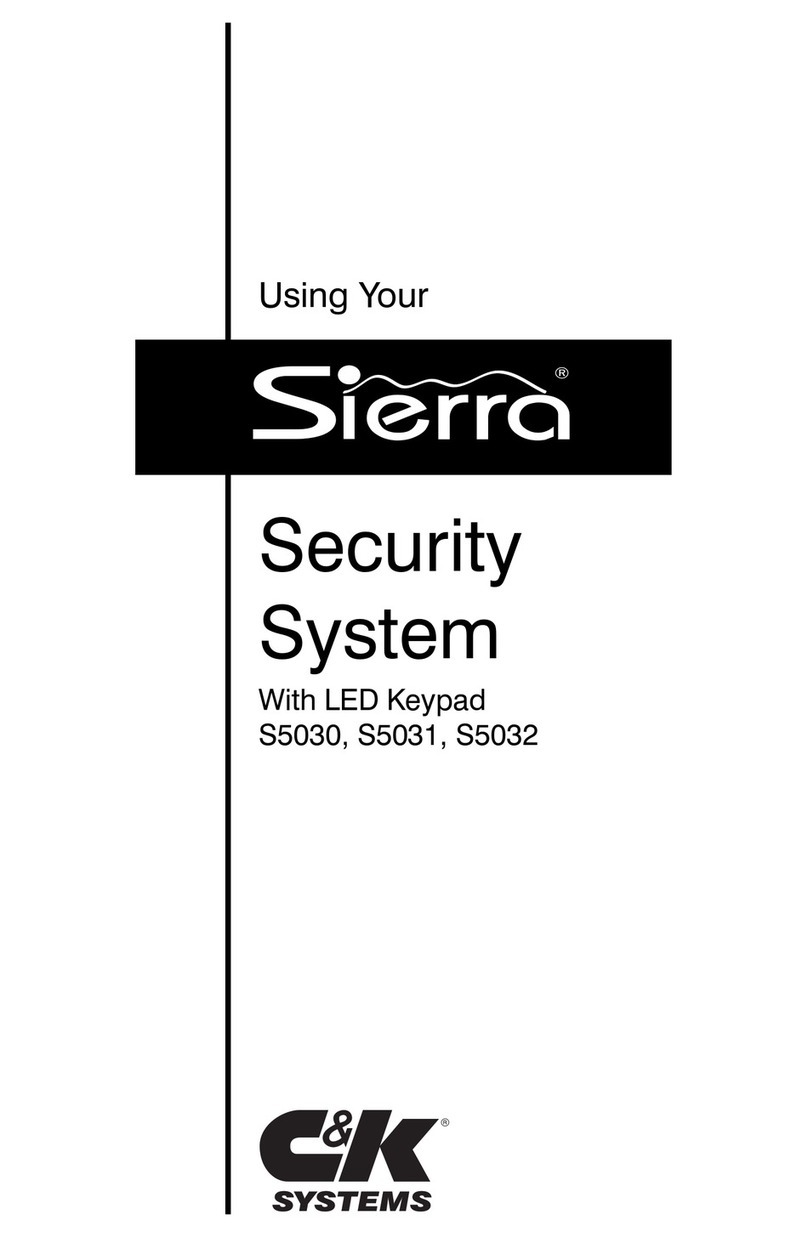
C & K Systems
C & K Systems Sierra User manual
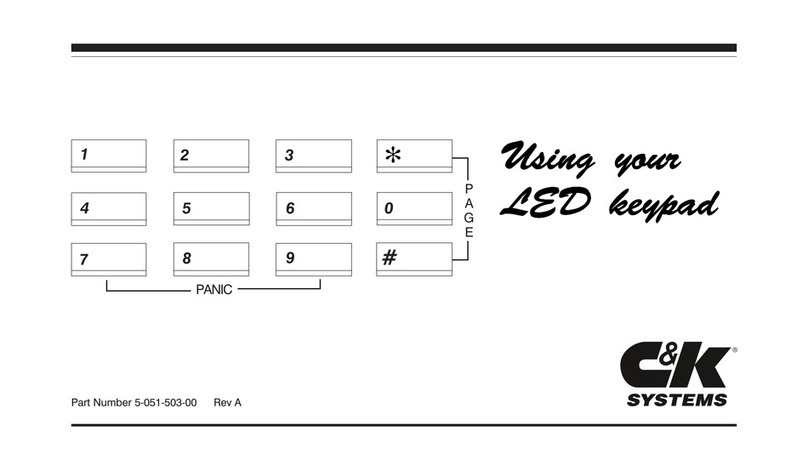
C & K Systems
C & K Systems 236E User manual
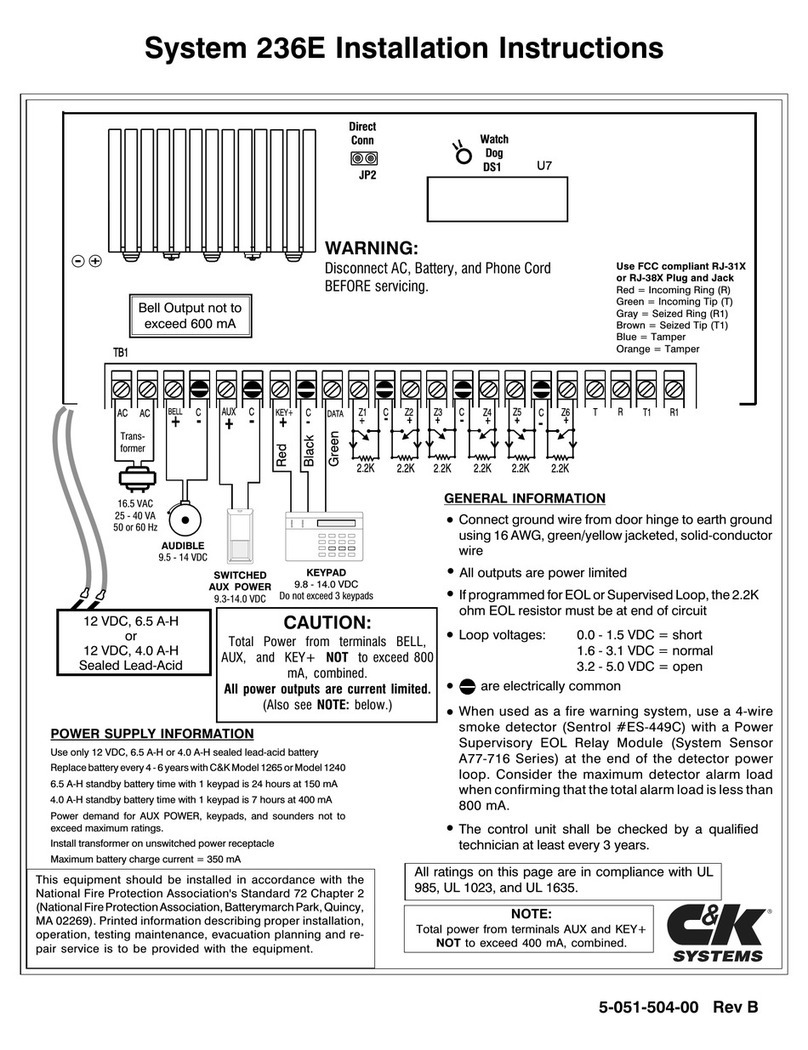
C & K Systems
C & K Systems 236E User manual
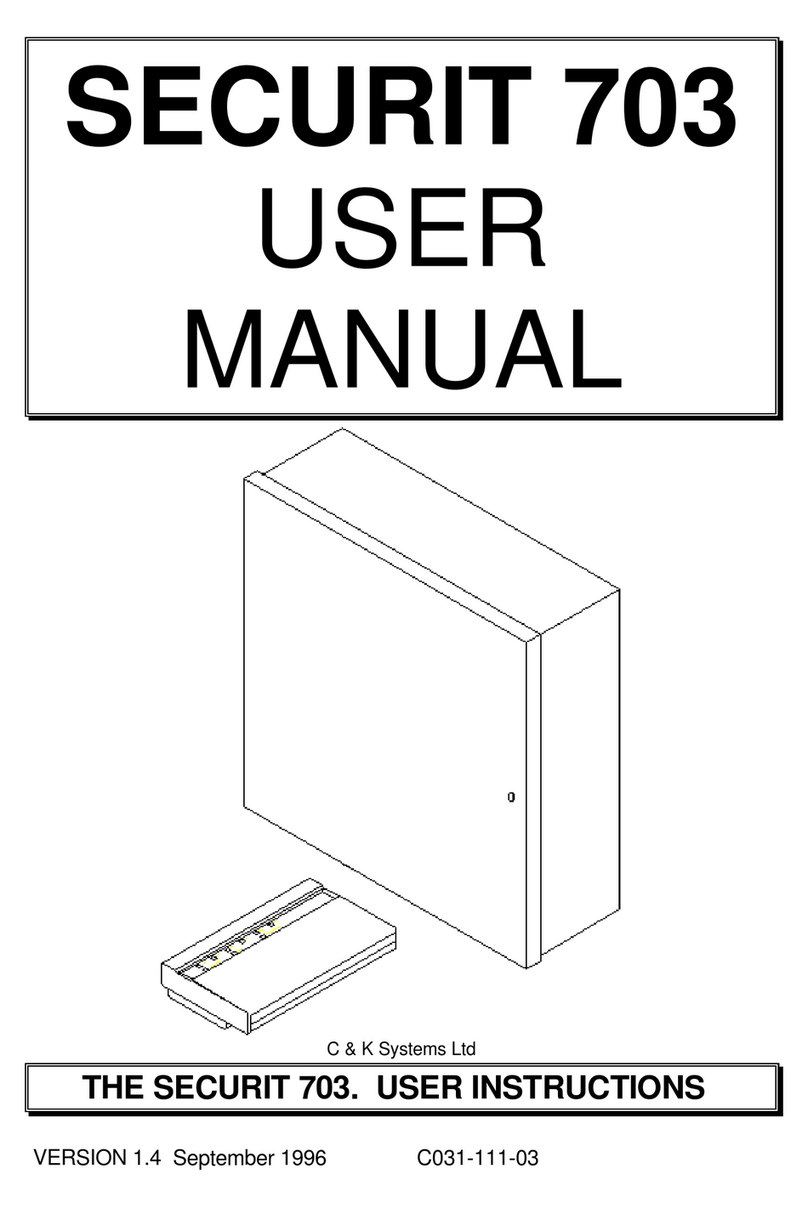
C & K Systems
C & K Systems Securit 703 User manual

C & K Systems
C & K Systems System 236i User manual
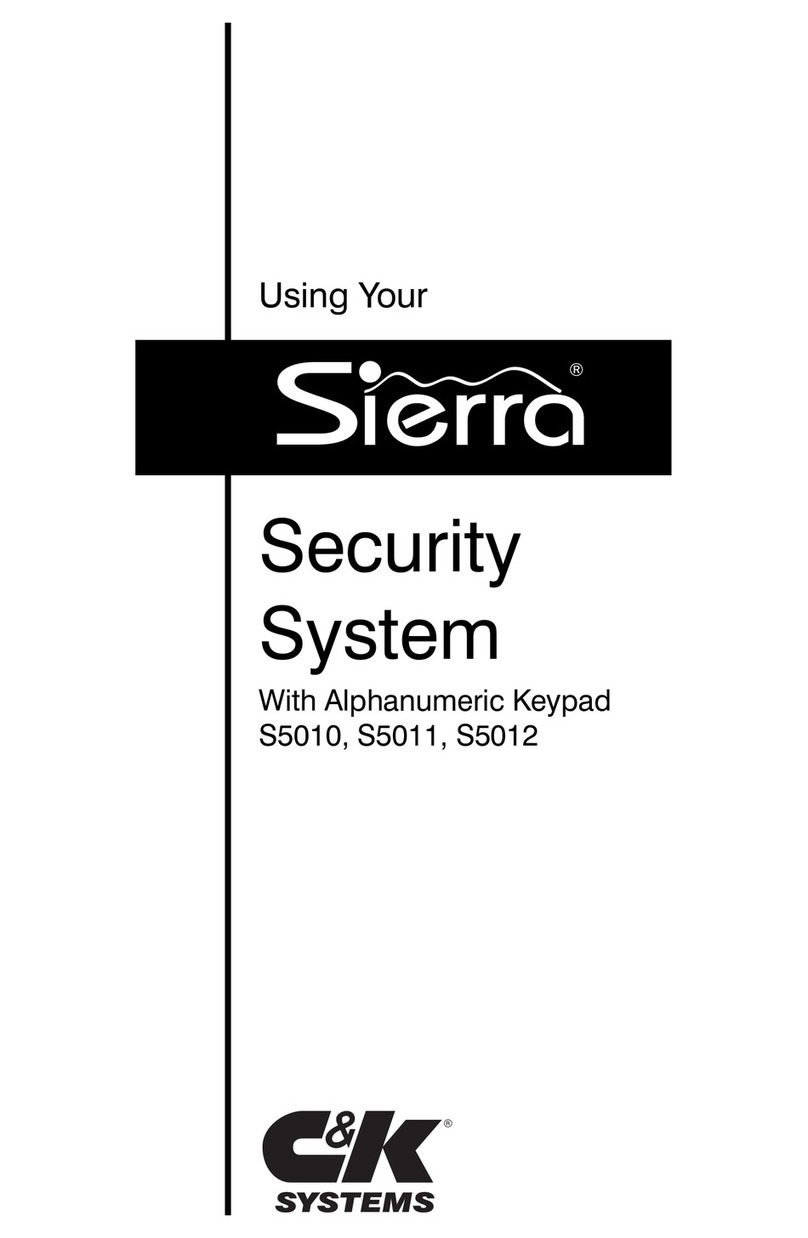
C & K Systems
C & K Systems S5010 Guide

C & K Systems
C & K Systems SpreadNet SN962-PENDANT User manual
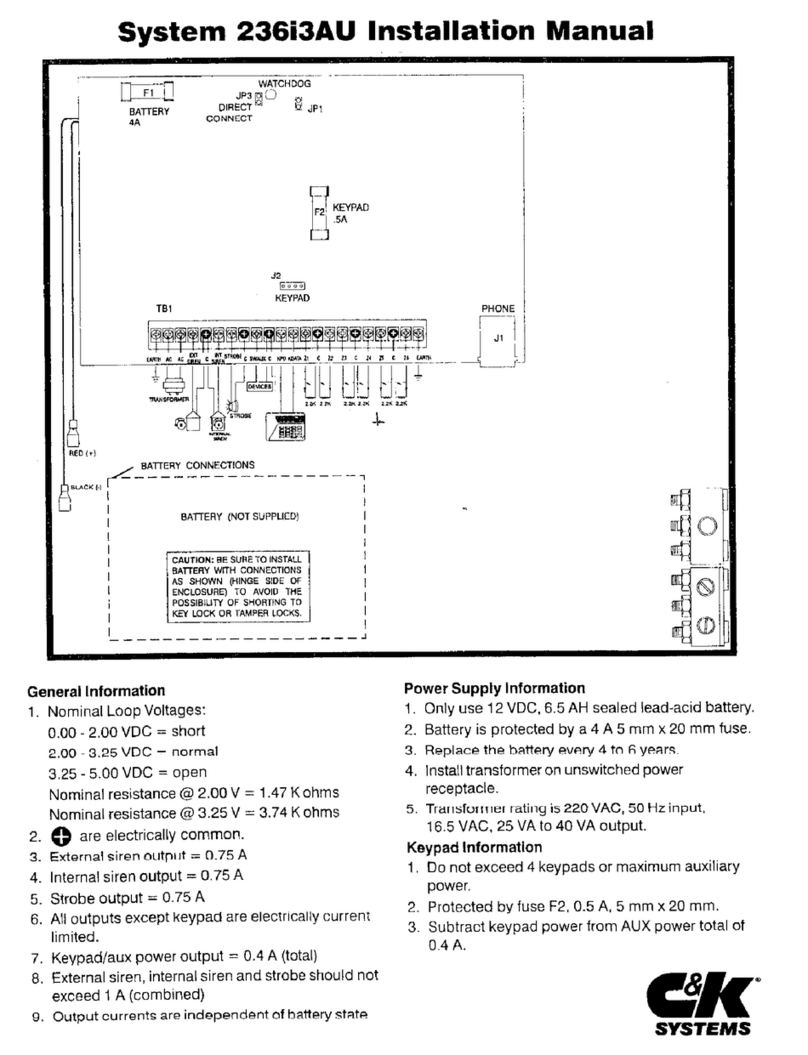
C & K Systems
C & K Systems 236I3AU User manual
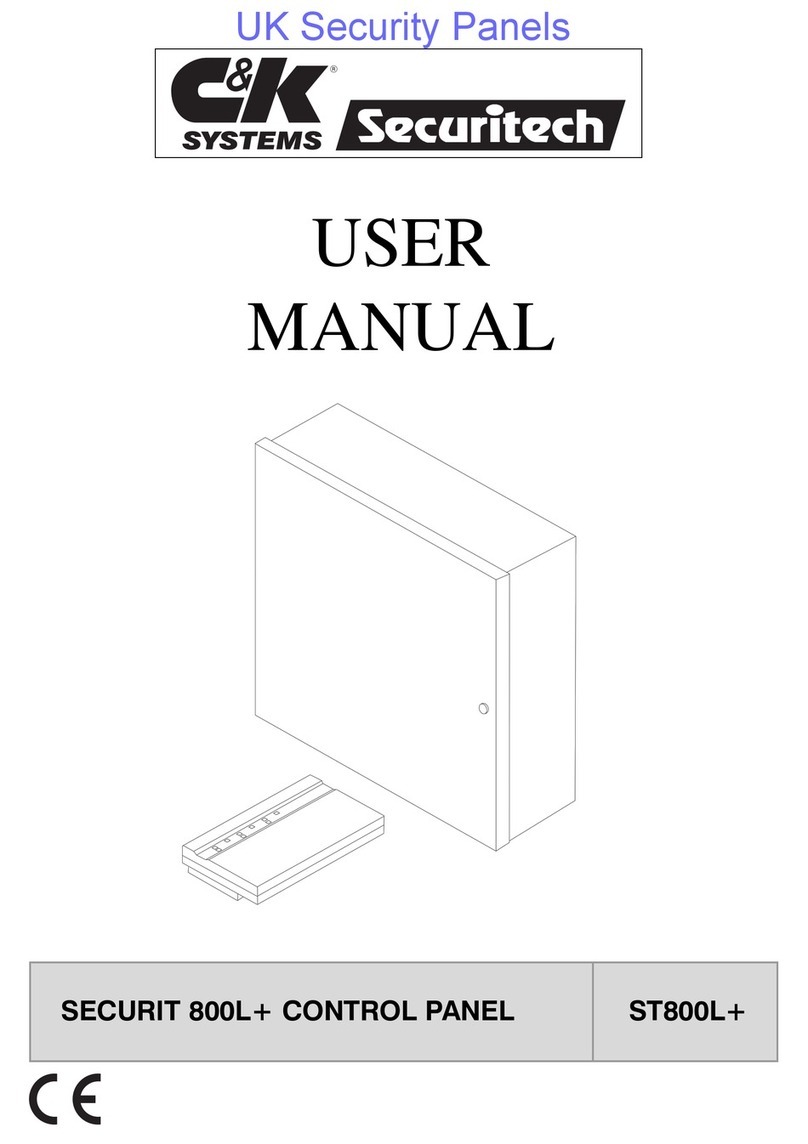
C & K Systems
C & K Systems SECURIT ST800L+ User manual

C & K Systems
C & K Systems Sierra Reference guide
